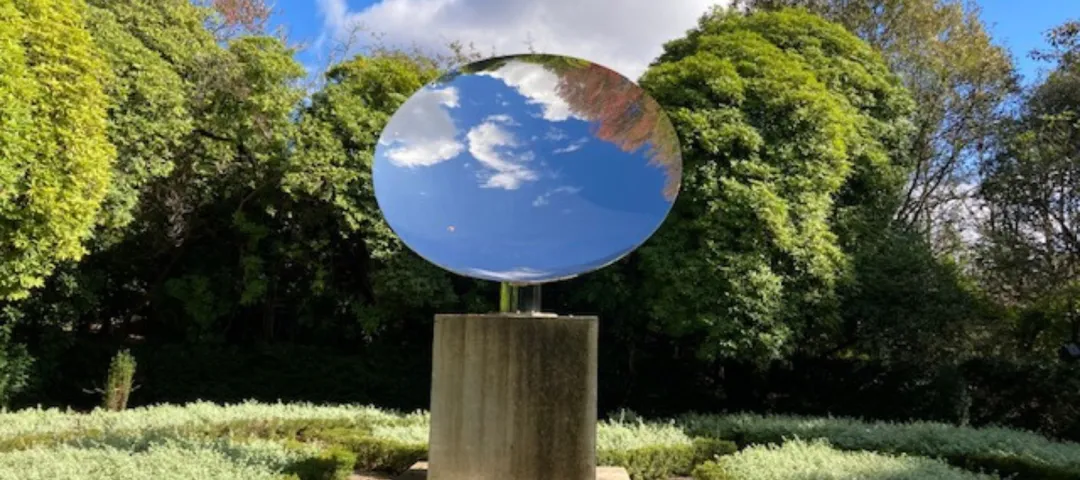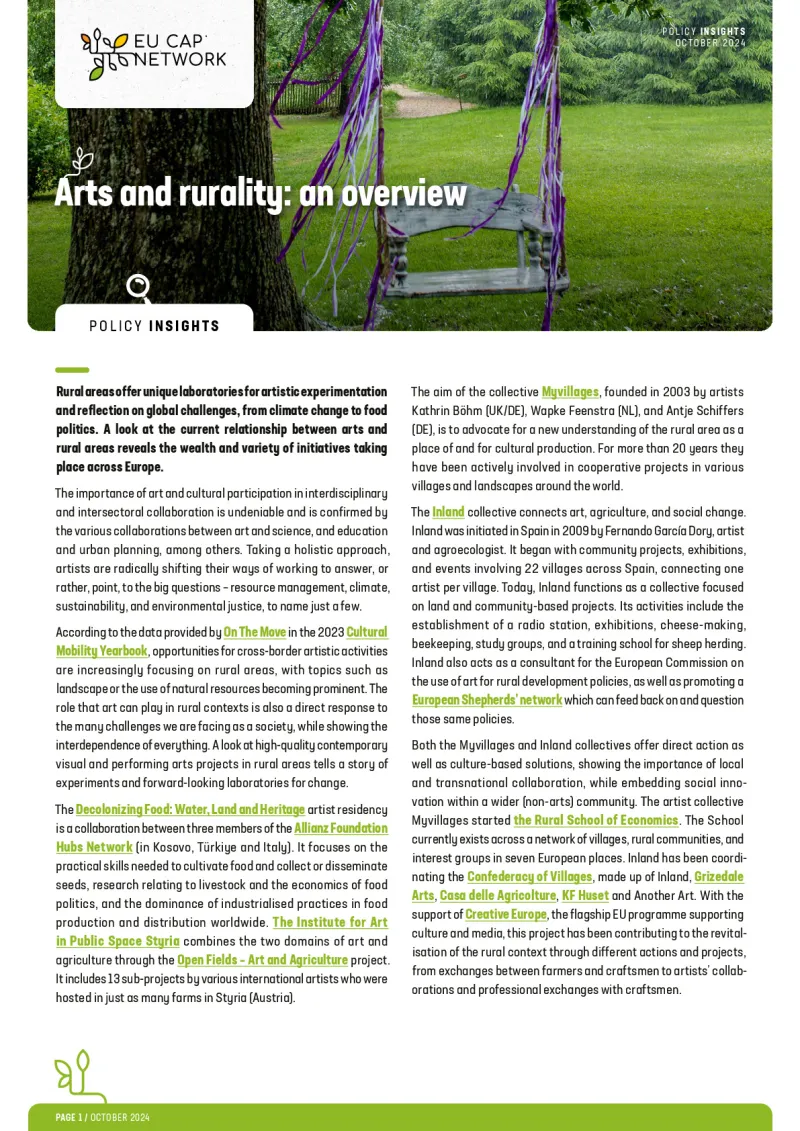Das wirtschaftliche und soziale Potenzial des ländlichen Kulturerbes nutzen
- GAP-Implementierung
- Umwelt
- Wachstum, Beschäftigung und Gleichstellung in ländlichen Gebieten
- Langfristige Vision für ländliche Gebiete
- Tourism
Das Kulturerbe ist aufgrund seiner sozialen Bedeutung und seines Potenzials für die Entwicklung des ländlichen Raums ein Gewinn für den ländlichen Raum Europas. Die Gemeinsame Agrarpolitik (GAP) bietet hier Chancen.
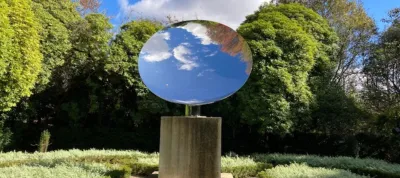
Page contents
Das Kulturerbe ist aufgrund seiner sozialen Bedeutung und seines Potenzials für die ländliche Entwicklung ein Gewinn für den ländlichen Raum Europas. Die Gemeinsame Agrarpolitik (GAP) bietet den EU-Ländern Möglichkeiten, die Schätze ihres natürlichen und kulturellen Erbes optimal zu nutzen.
Die Zusammenarbeit in kulturellen Angelegenheiten zwischen den EU-Ländern erfolgt häufig über das Programm „Kreatives Europa“ oder über das EU-Rahmenprogramm für Forschung und Innovation (derzeit Horizon Europa), das Projekte finanziert, die unter anderem nachhaltige und digitale Errungenschaften für ein widerstandsfähigeres, wettbewerbsfähigeres, integrativeres und demokratischeres Europa unterstützen.
Verwandte aktuelle politische Prognosen zur EU-Politik für das Kulturerbe für den Zeitraum 2024-2029 wurden von Mitgliedern des Europäischen Parlaments vorgelegt. In ihrer Think-Tank-Bewertung werden politische Prioritäten befürwortet, die die sektorübergreifende Zusammenarbeit stärken und gleichzeitig gute Arbeitsbedingungen fördern.
Der Kulturerbesektor der EU wird weithin als wichtig für die Beschäftigung anerkannt. Eurostat-Statistiken zeigen, dass dieser Sektor im Vergleich zu anderen Sektoren ein geringes geschlechtsspezifisches Beschäftigungsgefälle aufweist, und stellen fest, dass die Beschäftigung im Kulturbereich in den EU-Ländern zugenommen hat.
Die Bedeutung des ländlichen Kulturerbes wurde vom Europäischen Wirtschafts- und Sozialausschuss im Rahmen des Europäischen Jahres des Kulturerbes 2018 und dessen Nachfolgeinitiative, dem Europäischen Aktionsrahmen für das Kulturerbe, hervorgehoben. Diese Initiative würdigte den vielfältigen Wert des Kulturerbes, insbesondere im ländlichen Raum, wo Traditionen (einschließlich kulinarischer Traditionen), Landschaften und natürliche Ressourcen als Brücken zwischen den Erinnerungen an die Vergangenheit und den Zukunftsvisionen fungieren.
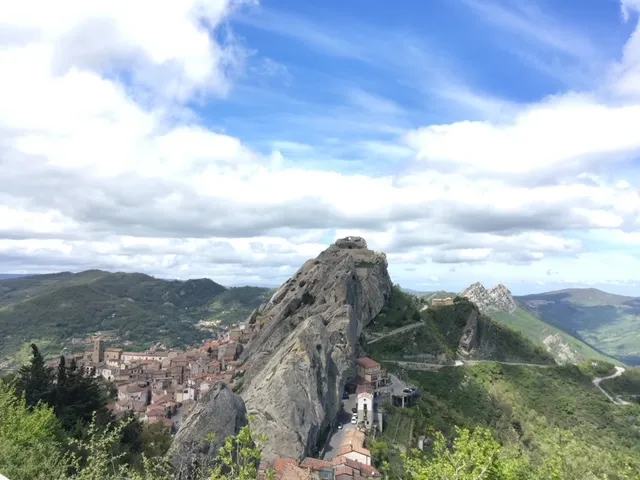
© Ariane Bieou
Der Wert des Kulturerbes als Ressource für die Entwicklung des ländlichen Raums wird auch durch die Faro-Konvention des Europarates von 2020 und deren Anerkennung, dass ländliche Gebiete herausragende Beispiele für Kulturerbe darstellen, untermauert. Die Konvention macht auf nützliche Managementtipps für die Politik, Programme und Projekte im Bereich des ländlichen Kulturerbes aufmerksam und empfiehlt Bottom-up-Ansätze, die „die Bürger und Kulturerbe-Gemeinschaften befähigen, sich aktiv an der (Neu-)Definition der Werte und Bedeutungen dieses Erbes zu beteiligen“.
Die Elemente des ländlichen Kulturerbes
Das ländliche Kulturerbe ist eine wertvolle Quelle für Geschichte, Kultur und Natur, die Menschen, Orte und Zeiten miteinander verbindet. Seine Bedeutung geht über die Erhaltung hinaus: Es vereint materielle, immaterielle und natürliche Elemente, die Gemeinschaften stärken, Nachhaltigkeit fördern und das Wohlbefinden verbessern, indem sie gemeinsame Werte fördern.
Materielle Elemente wie Gebäude, landwirtschaftliche Geräte und historische Wege sind physische Zeugnisse kultureller Kontinuität. Immaterielle Aspekte wie lebendige Traditionen und Bräuche, lebhafte Feste, lokale Gastronomie und Handwerkskunst verkörpern den Geist und die Identität ländlicher Gemeinschaften und sorgen dafür, dass ihr einzigartiger Charakter erhalten bleibt. Ergänzt werden diese durch das Naturerbe, darunter Landschaften, Biodiversität und Ökosysteme, das sowohl Lebensquelle als auch Raum von tiefer kultureller Bedeutung sein kann und Gemeinschaften auf sinnvolle Weise mit ihrer Umwelt verbindet.
Die Werte des ländlichen Kulturerbes
Das ländliche Erbe dient als Kanal für den Wissenstransfer zwischen den Generationen und ermöglicht den Austausch von Weisheiten, Fähigkeiten und Traditionen von älteren zu jüngeren Generationen. Wichtig ist, dass es die Fähigkeit besitzt, lokale Gemeinschaften zu mobilisieren, soziale, kulturelle und sogar digitale Verbindungen zu stärken und so sicherzustellen, dass ländliche Räume ein wichtiger Teil größerer Netzwerke bleiben und das Gefühl der „Abschottung“ begrenzt wird.
Der Ruractive-Ansatz fördert eine nachhaltige und integrative Entwicklung, die das Potenzial hat, alle Mitglieder ländlicher Gemeinschaften in ganz Europa zu stärken. Durch gemeinsam entwickelte, umgesetzte und überwachte Lösungen bindet er benachteiligte Gruppen in das Ökosystem „Hub of rural innovation“ ein, um soziale Ausgrenzung und Unterrepräsentation durch einen gezielten und integrativen Ansatz zu bekämpfen.
Wichtige Erkenntnisse über den Wert des ländlichen Erbes als Motor der ländlichen Entwicklung wurden im Rahmen des Projekts „Ruritage“ gewonnen, das das kulturelle und natürliche Erbe als Motor der ländlichen Erneuerung untersuchte und sich dabei auf akademische Themen konzentrierte, wie z. B.: partizipative Prozesse zur Erneuerung ländlicher Gebiete durch heritage-led plans; systemische Innovationsbereiche für bewährte Praktiken der heritage-led rural regeneration; und gemeinsame Entwicklung von heritage-led regeneration plans in ländlichen Gebieten.
Experimentierfelder für fruchtbare Lösungen

© Ariane Bieou
Wie wir aus den oben genannten Projekten lernen, trägt das ländliche Kulturerbe dazu bei, die Beziehung – und gegenseitige Abhängigkeit – zwischen städtischen Zentren und dem ländlichen Raum hervorzuheben. So kann es dazu beitragen, das gegenseitige Verständnis und die Integration zu fördern, mit dem Ziel, einen ausgewogenen Dialog zwischen diesen unterschiedlichen Umgebungen zu schaffen.
Ein Beispiel hierfür ist das Programm „Europäische Kulturhauptstädte“ (ECoCs), das sich zwar an Städte richtet, aber oft als Labor für nicht-städtische Gebiete dient.
Insbesondere in den letzten Jahren wurden auch kleine Städte zu ECoCs ernannt, und der Schwerpunkt des Programms jeder Kulturhauptstadt verlagerte sich ganz natürlich von einem ausschließlich stadtzentrierten Ansatz hin zu einer breiteren Dimension, die auch die umliegenden stadtnahen und ländlichen Gebiete einbezog. Dies betrifft die vorbereitenden Aktivitäten (die oft mehrere Monate oder sogar Jahre dauern), das Programm des Kernjahres und die langfristigen Auswirkungen auf das Gebiet und seine Bevölkerung. Infolgedessen sind lokale Traditionen und das lokale Erbe zu einem integralen Bestandteil der Kulturhauptstädte geworden, die das volle Potenzial des ländlichen Erbes durch langfristige, gemeinschaftsgeführte Prozesse erschließen, die lebendige und nachhaltige Lösungen fördern und Tradition und Innovation verbinden, um dauerhafte kulturelle, soziale und ökologische Auswirkungen zu erzielen.
Die ECoCs zeichnen sich in drei experimentellen Bereichen aus: Kulturrouten, die lokale und europäische Geschichten verbinden; Neuinterpretation von Bräuchen und Traditionen; und Integration von ökologischem Wissen in Landschaften und Nachhaltigkeitsbemühungen.
Ein symbolträchtiges Beispiel ist Matera 2019. Diese kleine italienische Stadt, die auch zum UNESCO-Weltkulturerbe gehört, wurde zusammen mit der umliegenden ländlichen Region Basilicata zur ECoC ernannt, und ihr Kulturprogramm wurde auf das reiche ländliche Erbe der Region ausgeweitet. Im Rahmen des Programms Matera 2019 sticht das Projekt „Open Sound“ hervor, das „alte Zukunft“ verbindet und populäre Tonarchive, Traditionen und Bräuche, regionale Landschaften und lokale Gemeinschaften miteinander verwebt. Das Projekt hat ein neues kulturelles und wirtschaftliches Modell hervorgebracht, das durch mehrjährige Beteiligung der Gemeinschaft und langjährige Partnerschaften entstanden ist und internationale Anerkennung gefunden hat.
In ähnlicher Weise entwickelt Bourges 2028 derzeit seinen Ansatz für die Kulturhauptstadt Europas in einem „ultra-ruralen“ Kontext (der abgelegenen französischen Provinz). Eine Vorzeigeaktivität ist das Projekt „RER Europa“, eine „touristische, kulturelle und ökologische Reise“, die das materielle, immaterielle und natürliche Erbe von Bourges miteinander verbindet und gleichzeitig innovative und dynamische Verbindungen zwischen städtischen und ländlichen Räumen fördert.
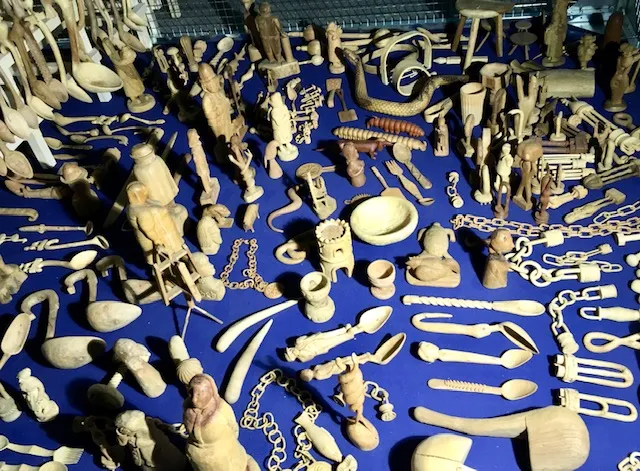
© Ariane Bieou
Die Pflege des Kulturerbes im ländlichen Raum trägt dazu bei, seine Rolle als lebendige Ressource zu sichern, die Innovation fördert und natürliche und kulturelle Ökosysteme erhält. Investitionen in Zeit und kreative Prozesse unter Federführung der ländlichen Gemeinden gewährleisten langfristig eine erhebliche Entwicklungswirkung zum Nutzen künftiger Generationen. Der Wert des ländlichen Erbes kann dann weit über die Erhaltung hinausgehen und einen Fahrplan für den Aufbau eines integrativeren und nachhaltigeren Europas bieten.
GAP-Maßnahmen für das ländliche Erbe – Bewährte Praktiken aus der EU
Die Gemeinsame Agrarpolitik (GAP) bietet zahlreiche Möglichkeiten zur Erhaltung und Förderung des ländlichen Erbes – sei es materiell, immateriell oder natürlich –, wie über 100 Projekte zeigen, die in der Datenbank für bewährte Praktiken des EU-GAP-Netzwerks zusammengestellt sind.
Das irische Förderprogramm für traditionelle landwirtschaftliche Gebäude, das zu den Preisträgern des European Heritage Awards 2024 gehörte, erhielt GAP-Mittel, um Landwirten bei der Instandsetzung und Modernisierung von über 1 000 traditionellen ländlichen Kulturgütern zu helfen.
Das kroatische Projekt zur Wiederherstellung von Trockenmauern als landschaftliches Merkmal kam sowohl der Biodiversität als auch der lokalen Wirtschaft zugute.
Eine aus der GAP finanzierte traditionelle Waldbildungseinrichtung in der Slowakei hilft Einwohnern und Touristen, ihr Naturerbe zu schätzen und zu bewahren, während Touristen in Finnisch-Lappland dank eines nachhaltigen Tourismusprojekts, das neue Beschäftigungsmöglichkeiten für die lokale Bevölkerung geschaffen hat, nun die lokale Hirtenkultur hautnah erleben können.
In Slowenien nutzt das Projekt „The Lore“ 3D- und Augmented-Reality-Technologien, um das Bewusstsein für das lokale Erbe zu fördern und eine Brücke zwischen älteren und jüngeren Generationen zu schlagen.
